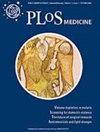Suicide after leaving the UK Armed Forces 1996–2018: A cohort study
IF 9.9
1区 医学
Q1 MEDICINE, GENERAL & INTERNAL
引用次数: 4
Abstract
Background: There are comparatively few international studies investigating suicide in military veterans and no recent UK studies. We aimed to investigate the rate, timing, and risk factors for suicide in personnel who left the UK Armed Forces (UKAF) over a 22-year period. Methods and findings: We conducted a retrospective cohort study of suicide in personnel who left the regular UKAF between 1996 and 2018 by linking national databases of discharged personnel and suicide deaths. Of the 458,058 individuals who left the UKAF, 1,086 (0.2%) died by suicide. The overall rate of suicide in veterans was not greater than the general population (SMR [95% CI] 94 [88-99]). However, suicide risk was two to four times higher in male and female veterans aged under 25 years than in the same age groups in the general population (age-specific mortality ratios ranging from 160 to 409). Male veterans aged 35 years and older were at reduced risk of suicide (age-specific mortality ratios 47 to 80). Male sex, Army service, discharge between the ages of 16 and 34 years, being untrained on discharge, and length of service under 10 years were associated with increased suicide risk. Factors associated with reduced risk included being married, a higher rank and deployment on combat operations. The rate of contact with specialist NHS mental health services (273/1,086, 25%) was lowest in the youngest age groups (10% for 16-19-year-olds; 23% for 20-24-year-olds). Conclusions: Suicide risk in veterans is not high but there are important differences according to age, with higher risk in young men and women. We found a number of factors which increased the risk of suicide but deployment was associated with reduced risk. Our focus should be on improving and maintaining access to mental health care and social supports for young service leavers, as well as implementing general suicide prevention measures for all veterans.1996-2018年离开英国武装部队后自杀:一项队列研究
背景:调查退伍军人自杀的国际研究相对较少,英国也没有最近的研究。我们的目的是调查22年期间离开英国武装部队(UKAF)人员的自杀率、时间和危险因素。方法和研究结果:我们通过连接退伍人员和自杀死亡的国家数据库,对1996年至2018年期间离开英国空军常规部队的人员的自杀进行了回顾性队列研究。在离开英国空军的458058人中,有1086人(0.2%)死于自杀。退伍军人的总体自杀率并不高于普通人群(SMR [95% CI] 94[88-99])。然而,25岁以下的男性和女性退伍军人的自杀风险是一般人群中相同年龄组的两到四倍(年龄死亡率从160到409不等)。35岁及以上的男性退伍军人自杀风险较低(年龄死亡率为47至80)。男性、服役、16至34岁之间的退伍、退伍时未受过训练、服役年限低于10年与自杀风险增加有关。与降低风险相关的因素包括结婚、更高的军衔和作战部署。在最年轻的年龄组(16-19岁为10%)中,与NHS专业精神卫生服务机构接触的比率(273/1,086,25%)最低;20-24岁23%)。结论:退伍军人自杀风险不高,但在年龄上存在显著差异,青年男性和女性自杀风险较高。我们发现了一些增加自杀风险的因素,但部署与降低风险有关。我们的重点应该放在改善和保持年轻退伍军人获得精神卫生保健和社会支持的机会,以及为所有退伍军人实施一般的自杀预防措施。
本文章由计算机程序翻译,如有差异,请以英文原文为准。
求助全文
约1分钟内获得全文
求助全文
来源期刊

PLoS Medicine
医学-医学:内科
CiteScore
21.60
自引率
0.60%
发文量
227
审稿时长
3 months
期刊介绍:
PLOS Medicine aims to be a leading platform for research and analysis on the global health challenges faced by humanity. The journal covers a wide range of topics, including biomedicine, the environment, society, and politics, that affect the well-being of individuals worldwide. It particularly highlights studies that contribute to clinical practice, health policy, or our understanding of disease mechanisms, with the ultimate goal of improving health outcomes in diverse settings.
Unwavering in its commitment to ethical standards, PLOS Medicine ensures integrity in medical publishing. This includes actively managing and transparently disclosing any conflicts of interest during the reporting, peer review, and publication processes. The journal promotes transparency by providing visibility into the review and publication procedures. It also encourages data sharing and the reuse of published work. Author rights are upheld, allowing them to retain copyright. Furthermore, PLOS Medicine strongly supports Open Access publishing, making research articles freely available to all without restrictions, facilitating widespread dissemination of knowledge. The journal does not endorse drug or medical device advertising and refrains from exclusive sales of reprints to avoid conflicts of interest.
 求助内容:
求助内容: 应助结果提醒方式:
应助结果提醒方式:


